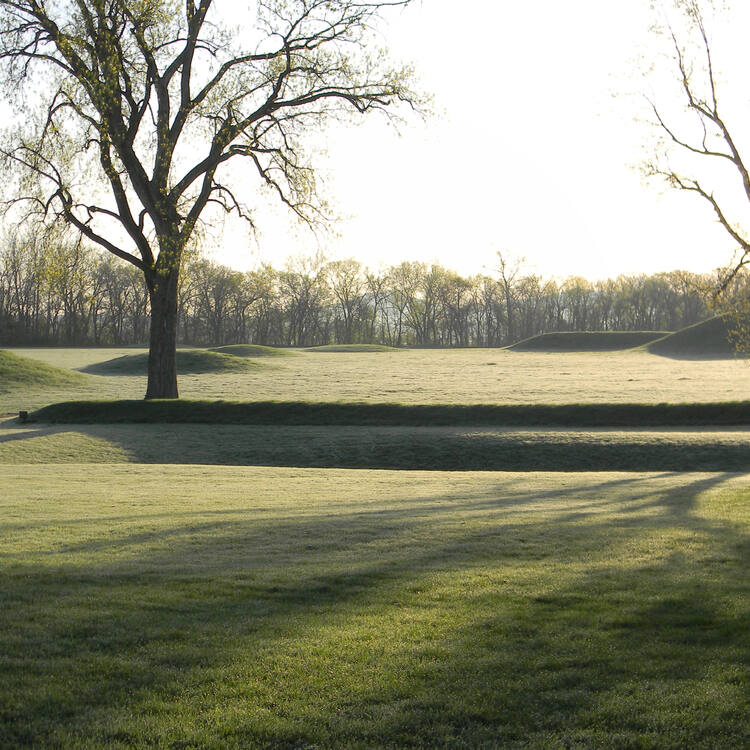Hopewell Ceremonial Earthworks
Hopewell Ceremonial Earthworks
Description is available under license CC-BY-SA IGO 3.0
Les ouvrages en terre cérémoniels Hopewell
Description is available under license CC-BY-SA IGO 3.0
التشكيلات الترابية الطقسية لهوبويل
source: UNESCO/CPE
Description is available under license CC-BY-SA IGO 3.0
霍普维尔仪式用土筑
source: UNESCO/CPE
Description is available under license CC-BY-SA IGO 3.0
Церемониальные земляные сооружения Хоупвелла
source: UNESCO/CPE
Description is available under license CC-BY-SA IGO 3.0
Obras en tierra ceremoniales Hopewell
source: UNESCO/CPE
Description is available under license CC-BY-SA IGO 3.0
Outstanding Universal Value
Brief synthesis
Hopewell Ceremonial Earthworks is a series of eight monumental earthen enclosure complexes built between 2,000 and 1,600 years ago along the central tributaries of the Ohio River in east-central North America. They are the most representative surviving expressions of the Indigenous tradition now referred to as the Hopewell culture. Their scale and complexity are evidenced in precise geometric figures as well as hilltops sculpted to enclose vast, level plazas. Huge earthen squares, circles, and octagons are executed with a precision of form, technique, and dimension consistently deployed across a wide geographic region. There are alignments with the cycles of the Sun and the far more complex cycles of the Moon. These earthworks served as ceremonial centres, built by dispersed, non-hierarchical groups whose way of life was supported by a mix of foraging and farming. The sites were the centre of a continent-wide sphere of influence and interaction, and have yielded finely crafted ritual objects fashioned from exotic raw materials obtained from distant places.
Criterion (i): Hopewell Ceremonial Earthworks comprises highly complex masterpieces of landscape architecture. They are exceptional amongst ancient earthworks worldwide not only in their enormous scale and wide geographic distribution, but also in their geometric precision. These features imply high-precision techniques of design and construction and an observational knowledge of complex astronomical cycles that would have required generations to codify. The series includes the finest extant examples of these various principles, shapes, and alignments, both in geometric earthworks and in the pre‑eminent surviving hilltop enclosure. They reflect the pinnacle of Hopewell intellectual, technical, and symbolic achievement.
Criterion (iii): Hopewell Ceremonial Earthworks bears exceptional testimony to the unique characteristics of their builders, who lived in small, dispersed, egalitarian groups, between 1 and 400 CE, amongst the river valleys of what is now southern and central Ohio. Their economy was a mix of foraging, fishing, farming, and cultivation, yet they gathered periodically to create, manage, and worship within these massive public works. The precision of their carefully composed earthen architecture, and its timber precursors, reflected an elaborate ceremonialism and linked it with the order and rhythms of the cosmos. The earthworks in this series, together with their archaeological remains, offer the finest extant testimony to the nature, scope, and richness of the Hopewell cultural tradition.
Integrity
All the attributes necessary to convey and sustain the Outstanding Universal Value are in the boundaries of the serial property. These include the earthwork walls, gateways, ditches, ponds, and in situ archaeological remains. The series is of sufficient size to ensure the complete representation of the features and values that convey the significance of the property, through the inclusion of the largest and best-preserved examples of each major geometric form found amongst Hopewell Ceremonial Earthworks, as well as the most important hilltop enclosure. In addition, all the component parts are complete and in good condition, with the ability to convey their large forms and the relationships amongst them. The property does not suffer from adverse effects of development and/or neglect, as each site is managed as a public park in rural or low-density suburban settings. The curated artefacts in site-based collections also support the understanding of the attributes.
Authenticity
Hopewell Ceremonial Earthworks is authentic to an extraordinary extent, given the long time that has elapsed since its construction, in terms of their locations and settings, forms and designs, materials and substance, and spirit and feeling. The locations for all the component parts are unchanged; the settings for the earthworks are still predominantly semirural or are in low-density residential districts buffered for most of their perimeters by parkland. In form and design, the enclosure walls and mounds remain mostly intact. High-resolution remote-sensing data for the Seip Earthworks, Hopewell Mound Group, Hopeton Earthworks, and High Bank Works component parts clearly show intact subsurface portions of wall and building constructions. The predominant materials and substance of the earthworks are likewise authentically preserved in the intact forms of Fort Ancient and the component parts at the Newark Earthworks complex, and in the in situ archaeological remains at all the other sites.
Protection and management requirements
All the component parts are protected as national or State parks. Rigorous federal, state, and local protective measures are also in place to ensure the continued conservation and protection of the property. The buffer zones provide additional protection around the component parts.
Detailed management plans are in place for all eight component parts, following the established policies and legal requirements of their respective governmental owner agencies, the Ohio History Connection and the United States National Park Service, whose local representatives work closely together to provide consistent and coordinated management for the series. All features and elements within the boundaries of the property are closely monitored on a regular basis by professional expert staff from the two owner agencies. Regular maintenance and periodic conservation programmes ensure that the sites, features, and resources will be sustained in a superior state of conservation in the future.
